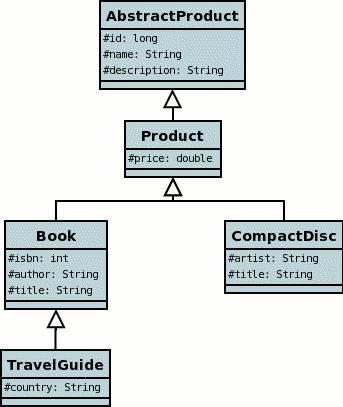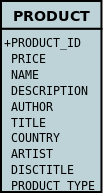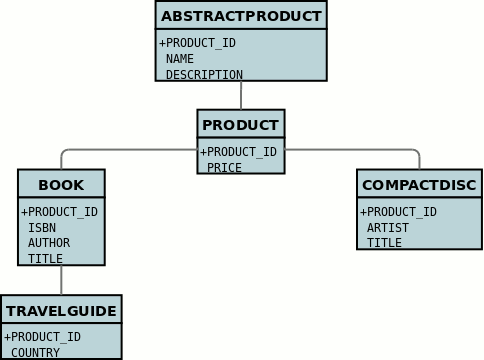
|

|

|

|

|

|

|
|
| DataNucleus AccessPlatform 4.1 Documentation |
|
In Java it is a normal situation to have inheritance between classes. With JPA you have choices to make as to how you want to persist your classes for the inheritance tree. For each inheritance tree (for the root class) you select how you want to persist those classes information. You have the following choices.
In order to demonstrate the various inheritance strategies we need an example. Here are a few simple classes representing products in a (online) store. We have an abstract base class, extending this to provide something that we can represent any product by. We then provide a few specialisations for typical products. We will use these classes later when defining how to persistent these objects in the different inheritance strategies.

The default JPA strategy is "SINGLE_TABLE", namely that the base class will have a table and all subclasses will be persisted into that same table. So if you dont specify an "inheritance strategy" in your root class this is what you will get.
| Please note that you must specify the identity of objects in the root persistable class of the inheritance hierarchy. You cannot redefine it down the inheritance tree |
See also :-
| Applicable to RDBMS, HBase, MongoDB |
A discriminator is an extra "column" stored alongside data to identify the class of which that information is part. It is useful when storing objects which have inheritance to provide a quick way of determining the object type on retrieval. A discriminator in JPA will store the a specified value (or the class name if you provide no value). You specify a discriminator as follows
<entity name="mydomain.Product">
<discriminator-column name="OBJECT" discriminator-type="STRING"/>
<discriminator-value>MyClass</discriminator-value>
...or with annotations
@Entity
@DiscriminatorColumn(name="OBJECT_TYPE", discriminatorType=DiscriminatorType.STRING)
@DiscriminatorValue("MyClass")
public class Product {...}| Applicable to RDBMS |
"SINGLE_TABLE" strategy is where the root class has a table and all subclasses are also persisted into that table. This corresponds to JDOs "new-table" for the root class and "superclass-table" for all subclasses. This has the advantage that retrieval of an object is a single DB call to a single table. It also has the disadvantage that the single table can have a very large number of columns, and database readability and performance can suffer, and additionally that a discriminator column is required. In our example, lets ignore the AbstractProduct class for a moment and assume that Product is the base class (with the "id"). We have no real interest in having separate tables for the Book and CompactDisc classes and want everything stored in a single table PRODUCT. We change our MetaData as follows
<entity name="Product">
<inheritance strategy="SINGLE_TABLE"/>
<discriminator-value>PRODUCT</discriminator-value>
<discriminator-column name="PRODUCT_TYPE" discriminator-type="STRING"/>
<attributes>
<id name="id">
<column name="PRODUCT_ID"/>
</id>
<basic name="price">
<column name="PRICE"/>
</basic>
</attributes>
</entity>
<entity name="Book">
<discriminator-value>BOOK</discriminator-value>
<attributes>
<basic name="isbn">
<column name="ISBN"/>
</basic>
<basic name="author">
<column name="AUTHOR"/>
</basic>
<basic name="title">
<column name="TITLE"/>
</basic>
</attributes>
</entity>
<entity name="TravelGuide">
<discriminator-value>TRAVELGUIDE</discriminator-value>
<attributes>
<basic name="country">
<column name="COUNTRY"/>
</basic>
</attributes>
</entity>
<entity name="CompactDisc">
<discriminator-value>COMPACTDISC</discriminator-value>
<attributes>
<basic name="artist">
<column name="ARTIST"/>
</basic>
<basic name="title">
<column name="DISCTITLE"/>
</basic>
</attributes>
</entity>or using annotations
@Entity
@Inheritance(strategy=InheritanceType.SINGLE_TABLE)
public class Product {...}This change of use of the inheritance element has the effect of using the PRODUCT table for all classes, containing the fields of Product, Book, CompactDisc, and TravelGuide. You will also note that we used a discriminator-column element for the Product class. The specification above will result in an extra column (called PRODUCT_TYPE) being added to the PRODUCT table, and containing the "discriminator-value" of the object stored. So for a Book it will have "BOOK" in that column for example. This column is used in discriminating which row in the database is of which type. The final thing to note is that in our classes Book and CompactDisc we have a field that is identically named. With CompactDisc we have defined that its column will be called DISCTITLE since both of these fields will be persisted into the same table and would have had identical names otherwise - this gets around the problem.

In the above example, when we insert a TravelGuide object into the datastore, a row will be inserted into the PRODUCT table only.
| Applicable to RDBMS |
"JOINED" strategy means that each entity in the inheritance hierarchy has its own table and that the table of each class only contains columns for that class. Inherited fields are persisted into the tables of the superclass(es). This corresponds to JDO2s "new-table" (for all classes in the inheritance hierarchy). This has the advantage of being the most normalised data definition. It also has the disadvantage of being slower in performance since multiple tables will need to be accessed to retrieve an object of a sub-type. Let's try an example using the simplest to understand strategy JOINED. We have the classes defined above, and we want to persist our classes each in their own table. We define the Meta-Data for our classes like this
<entity class="AbstractProduct">
<inheritance strategy="JOINED"/>
<attributes>
<id name="id">
<column name="PRODUCT_ID"/>
</id>
<basic name="name">
<column name="NAME"/>
</basic>
<basic name="description">
<column name="DESCRIPTION"/>
</basic>
</attributes>
</entity>
<entity class="Product">
<attributes>
<basic name="price">
<column name="PRICE"/>
</basic>
</attributes>
</entity>
<entity class="Book">
<attributes>
<basic name="isbn">
<column name="ISBN"/>
</basic>
<basic name="author">
<column name="AUTHOR"/>
</basic>
<basic name="title">
<column name="TITLE"/>
</basic>
</attributes>
</entity>
<entity class="TravelGuide">
<attributes>
<basic name="country">
<column name="COUNTRY"/>
</basic>
</attributes>
</entity>
<entity class="CompactDisc">
<attributes>
<basic name="artist">
<column name="ARTIST"/>
</basic>
<basic name="title">
<column name="TITLE"/>
</basic>
</attributes>
</entity>or using annotations
@Entity
@Inheritance(strategy=InheritanceType.JOINED)
public class Product {...}So we will have 5 tables - ABSTRACTPRODUCT, PRODUCT, BOOK, COMPACTDISC, and TRAVELGUIDE. They each contain just the fields for that class (and not any inherited fields, except the identity to join with).

In the above example, when we insert a TravelGuide object into the datastore, a row will be inserted into ABSTRACTPRODUCT, PRODUCT, BOOK, and TRAVELGUIDE.
| Applicable to all datastores |
This strategy is like "JOINED" except that in addition to each class having its own table, the table also holds columns for all inherited fields. So taking the same classes as used above
<entity class="AbstractProduct">
<inheritance strategy="TABLE_PER_CLASS"/>
<attributes>
<id name="id">
<column name="PRODUCT_ID"/>
</id>
<basic name="name">
<column name="NAME"/>
</basic>
<basic name="description">
<column name="DESCRIPTION"/>
</basic>
</attributes>
</entity>
<entity class="Product">
<attributes>
<basic name="price">
<column name="PRICE"/>
</basic>
</attributes>
</entity>
<entity class="Book">
<attributes>
<basic name="isbn">
<column name="ISBN"/>
</basic>
<basic name="author">
<column name="AUTHOR"/>
</basic>
<basic name="title">
<column name="TITLE"/>
</basic>
</attributes>
</entity>
<entity class="TravelGuide">
<attributes>
<basic name="country">
<column name="COUNTRY"/>
</basic>
</attributes>
</entity>
<entity class="CompactDisc">
<attributes>
<basic name="artist">
<column name="ARTIST"/>
</basic>
<basic name="title">
<column name="TITLE"/>
</basic>
</attributes>
</entity>or using annotations
@Entity
@Inheritance(strategy=InheritanceType.TABLE_PER_CLASS)
public class Product {...}This then implies a datastore schema as follows

So any object of explicit type Book is persisted into the table BOOK. Similarly any TravelGuide is persisted into the table TRAVELGUIDE, etc In addition if any class in the inheritance tree is abstract then it won't have a table since there cannot be any instances of that type. DataNucleus currently has limitations when using a class using this inheritance as the element of a collection.
JPA defines entities called "mapped superclasses" for the situation where you dont persist an actual object of a superclass type but that all subclasses of that type that are entities will also persist the values for the fields of the "mapped superclass". That is a "mapped superclass" has no table to store its objects in a datastore. Instead its fields are stored in the tables of its subclasses. Let's take an example
<mapped-superclass class="AbstractProduct">
<attributes>
<id name="id">
<column name="PRODUCT_ID"/>
</id>
<basic name="name">
<column name="NAME"/>
</basic>
<basic name="description">
<column name="DESCRIPTION"/>
</basic>
</attributes>
</mapped-superclass>
<entity class="Product">
<attributes>
<basic name="price">
<column name="PRICE"/>
</basic>
</attributes>
</entity>In this case we will have a table for Product and the fields of AbstractProduct will be stored in this table. If the mapping information (column names etc) for these fields need setting then you should use <attribute-override> in the MetaData for Product.